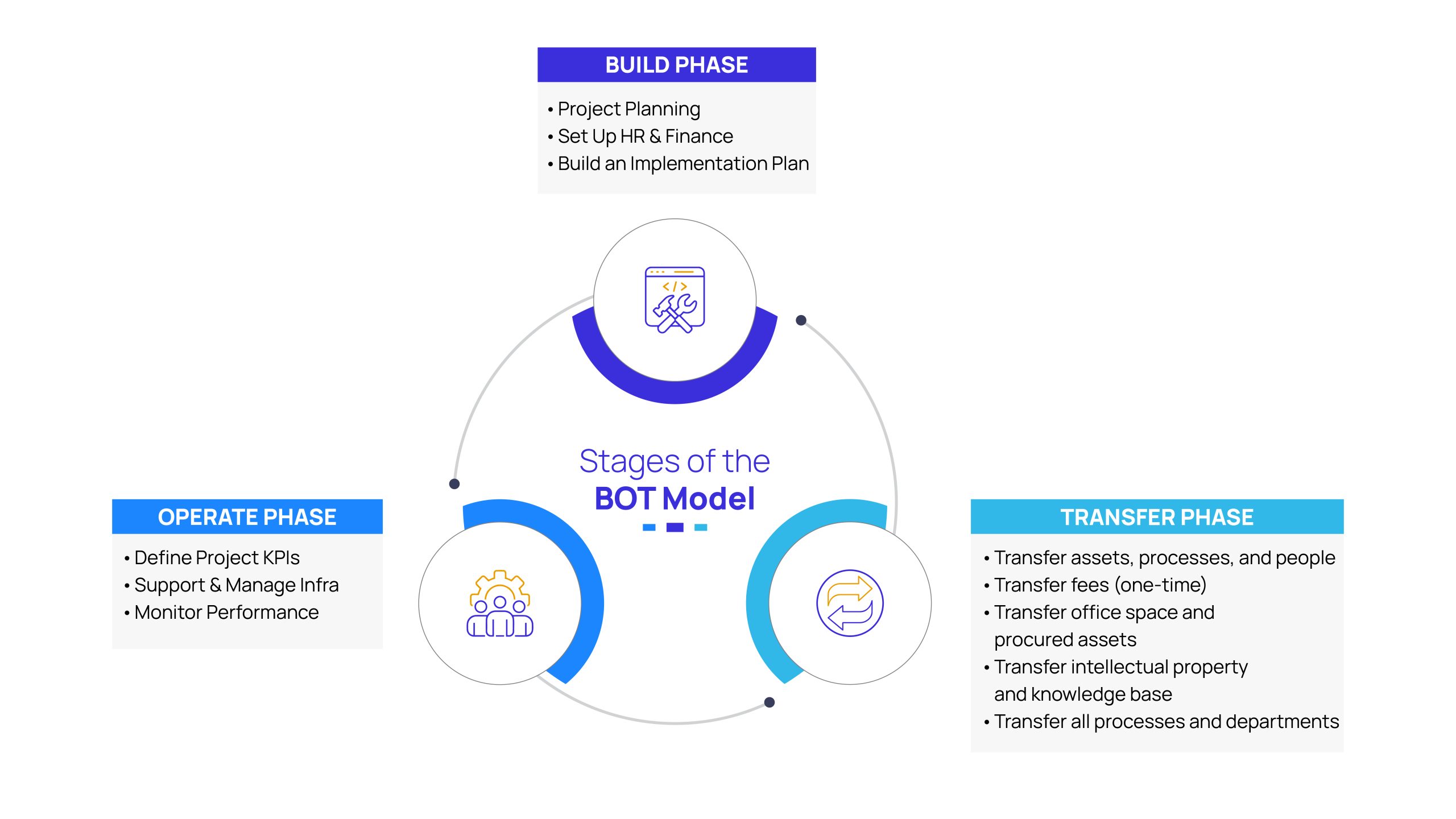IT outsourcing partnerships have gained widespread acceptance among enterprises across industries in today’s modern era. The outsourced service delivery model has enabled enterprises to compete more efficiently by redirecting their focus toward developing core business strategies.
However, the managed services model has its challenges. While managed services contracts help organizations delegate their IT requirements, the shift to or between managed services partners often leads to disruptions in business continuity due to the restructuring of people, processes, and infrastructure. Additionally, the managed services partner (MSP) is bound to adhere to agreed SLAs (service level agreements) for contracted service lines but is not accountable for how different service lines collectively contribute to achieving the organization’s overall business goals. And finally, there are ongoing concerns around intellectual property.
There is a need for a more flexible outsourced service delivery model that gives the enterprise more control over its IP, is more tightly integrated with the business and its goals and is better aligned with its culture. The Build-Operate-Transfer (BOT) model addresses the challenges of the traditional managed services model by assisting the organization in establishing its subsidiary unit end-to-end, which eventually, at the culmination of the contract, is transferred to the client.
This blog will explore the BOT model in detail, including its pros and cons over managed services.
According to Gartner, “Build-operate-transfer (BOT) is a contractual relationship in which an organization hires a service provider to set up, optimize and run an IT or business process service delivery operation with the contractually stipulated intent of transferring the operation to the organization as a captive center. BOT, as a hybrid model, combines elements of the “build” option (that is, “insourcing” or captive center) and the “buy” option (that is, outsourcing).”
Stages of the BOT Model

Let us explore how the BOT model functions with the help of an example. Here, the contract duration for the sample BOT model is 24 months.
BUILD PHASE: This phase involves extensive activities focused on setting up the operational unit. It encompasses selecting, setting up, and deploying physical and IT infrastructure. This stage includes activities related to recruitment, implementation planning, and establishing frameworks and processes (e.g., legal and administrative). In the normal course, the following steps may entail:
Project Planning
- Define project scope and vision
- Set up office space
- Handle legal aspects
- Finalize the technology stack
- Procure hardware
- Develop a governance mechanism
Set Up HR & Finance
- Establish the organizational structure
- Link roles with the RACI matrix
- Identify recruitment outsourcing partner
- Establish the finance and payroll department
Build an Implementation Plan
- Establish discovery teams for process identification
- Identify vendors needed for the delivery
- Prepare a roadmap for implementation
- Establish a vendor management plan
- Establish training plans for fresh recruits
This phase may take three months to accomplish.
OPERATE PHASE: The managerial stage commences at this phase. The service provider assumes responsibility for managing daily operations, defining project KPIs, and overseeing enhancements, product development, management, maintenance, monitoring, and support. The hired team collaborates on tools and processes while aligning with the organization’s corporate culture.
Define Project KPIs
- Define customized metrics aligning with overall business expectations
- Define performance monitoring metrics
- Establish a responsibility matrix
Support & Manage Infra
- Maintain and manage IT assets
- Create and maintain a knowledge repository
- Establish business continuity plans
- Develop continuous improvement plans
Monitor Performance
- Check SLA & XLA adherence
- Set up periodic reviews & reporting
- Monitor resource utilization & productivity
- Monitor business goals and ROI
- Protect the client’s intellectual property
As per our sample model, this stage takes 20 months.
TRANSFER PHASE: In this phase, the service provider legally transfers the team as a subsidiary of the contracted organization. This transfer includes project ownership, intellectual property, operations knowledge base, and any other acquired physical and technological assets. This is how transfer takes place:
- Transfer ownership of all assets, processes, and people to the contracted enterprise.
- Charge one-time transfer fees to give up employer rights to the client.
- Transfer office space and procured assets to the client.
- Transfer any intellectual property and knowledge base to the client
- Transfer all processes and departments to the client, including training, HR, and finance departments.
According to our sample model, this stage lasts around one month.
Advantages Over the Managed Services Model
The BOT model has several advantages over the managed services model.
Ownership
In managed services, the client receives ongoing services and support for the contracted period, and the service provider retains the resources at the end of the contract. In the BOT model, the ownership of assets and the entire subsidiary unit, along with its people and processes, is transferred to the client at the end of the contract.
Flexibility & Customization
The MSP maintains and controls operational activities as per the agreed contract at the start of the engagement and operates under directed SLAs. In BOT, the client gets more flexibility over the design, implementation, and usage of tools/processes according to their company culture. Additionally, transferred resources can be reallocated to different internal projects based on business needs after the transfer phase.
Metrics
The MSP strictly adheres to the agreed SLAs and XLAs for the contracted service lines. However, in the BOT model, in addition to adhering to SLAs and XLAs, service providers are also responsible for validating if overall business goals are met through consolidated operations of all service lines.
Employee Rights
Although the workforce outsourced in the managed services model operates to maintain BAU activities for the client, the employer rights remain with the service provider. The workforce outsourced in the BOT model works under the employer brand from the first day and continues to work for the client post the transfer phase when the service provider exits the partnership.
Risk & Investment
The client bears the initial investment and associated risks, and the MSP is liable to deliver services as per the agreed terms. Whereas, under the BOT model, the service provider assumes the risk of the initial investment, such as setting up the physical and technological infrastructure and covering recruitment costs. The client benefits from limited upfront investment and pays the service provider an agreed annual fee for its services.
Commercial Construct
Although the exact cost elements may differ based on the agreed service contract between the client and the service provider, the following represents the standard commercial structure of the different phases of the BOT delivery model.
Build Phase
- Vendors contribute much of the initial investment, while the client is not compelled to invest or invests only a small amount.
- The service contract specifies that the investment made by the service provider includes building the facility (physical & technological infrastructure), establishing the recruiting process, handling legal and compliance regulations, and laying the foundation for service delivery.
- The service provider recovers its investment in the subsequent phases.
Operate Phase
- To cover operational costs, perform regular business operations, and ensure compliance with pre-established SLAs, the service provider charges the client a recurring fee.
- The recurring payment includes the service provider’s margins, typically 2-5% more than those in a purely outsourced construct.
- The additional margin frequently depends on the size, scope, and type of the services, the service provider profile, the size of the initial investment, and the lock-in term.
Transfer Phase
- The service provider may charge the client a one-time transfer fee, varying between 20-30%, depending on contractual commitments.
- During the build phase, this fee is typically a portion of the ongoing annual fee; the client and service provider may predefine this portion in the service contract.
- If rebadging of resources is necessary, the service provider will charge the business a one-time transfer fee in exchange for relinquishing employer rights over the successfully rebadged resources.
It’s worth noting that a BOT-model delivery usually costs approximately 20-25% more than a typical outsourcing model.
Risks from the Client & Service Provider’s Side
The BOT model risks discouraging service providers from providing their best work, promoting transformation, and innovating when they know that the service and the associated revenue are finite. The contract must have specific service levels and innovation goals to address this. When both sides are driven to work toward the same goal, it fosters a strong working relationship and blended culture that helps reduce these risks.
To transform an organization, multiple parties often need to share responsibility for altering the work done by business services and the operating model components of employees, suppliers, customers, and other partners. The service provider can participate in the change, but it must be a team effort, and both parties must co-invest to reap the financial benefits.
Service providers invest a lot of time and effort in shaping the resources; hence, retaining their best-performing employees until the transfer phase can be a major challenge. Resignation of any trained resource just before the transfer phase can affect the success of the engagement.
Benefits of BOT Model Delivery
Upfront Cost Savings: The BOT model enables organizations to save on upfront costs as the service provider assumes the initial investment and operational expenses. This reduces financial uncertainties and minimizes operational and managerial oversight responsibilities.
Flexibility: The BOT model offers greater flexibility to adapt to changing business needs. The client has more control compared to a pure managed services arrangement, allowing them to customize projects and tasks to accommodate fluctuations in demand. They can quickly ramp resources up or down to meet overall business requirements.
Easy Delegation: All administrative activities, including employing staff and tax management, are handled by the IT service provider in an offshore location. The service provider employs advocates with expertise in IT and regional laws to ensure the legitimacy of the client’s offshore office operations and facilitate a smooth transfer. This enables the client to focus primarily on their core business while minimizing the time spent managing operational processes.
Alignment with Organizational Culture: From the beginning of the engagement, the client shares their best practices, technology stack, tools, communication frameworks, and processes with the IT service provider. This ensures complete alignment with the organization’s culture, facilitating a seamless transfer of the entire unit back to the client when the contract concludes.
The BOT Model is Not Always the Solution
The BOT model is not always the ideal solution. Here are some reasons why it may not be suitable in certain situations:
High Dependence on the Service Provider: While the BOT model offers the advantage of delegating various tasks to the IT service provider, it can also result in a high reliance on the provider. This dependence can lead to overcharging for services due to lacking local knowledge. It is crucial to thoroughly research and assess the expertise and credibility of potential service providers before entering a contractual partnership.
Short-term Projects: The BOT model is often associated with strategic investments and long-term commitments. Suppose the organization has short-term or tactical initiatives that do not require significant upfront commitments, long-term partnerships, or resource transfers. In that case, managing them through traditional outsourcing or project-based engagements may be more cost-effective and efficient.
Dynamic Business Environment: The BOT model’s long-term commitments and fixed structure might not suit companies operating in highly dynamic business environments where market conditions frequently change. A more flexible and adaptable strategy, such as agile development or on-demand outsourcing, may be more appropriate.
BOT Governance
To ensure successful implementation of the BOT model, it is essential to establish governance committees from the beginning. These committees should clearly understand their tasks, objectives, responsibilities, outputs, and reporting requirements. Creating separate committees for each BOT stage and a dedicated committee overseeing the entire process increases the likelihood of success. Including crucial members from both the client and supplier sides in these committees is essential, as is common in all governance committees.
To facilitate a smooth transfer of services to the client, it is advisable to focus on designing and implementing governance services. The client can stay well-informed about any unique aspects of the services by establishing a governance committee dedicated to BOT supervision. This committee can maintain regular communication with key management employees, making the future transfer phase much simpler and more streamlined. By emphasizing effective governance throughout the BOT engagement, the client can ensure better control and a successful transition of services back to their organization.
BOT 2.0
The traditional BOT was limited to operating from a single site and did not consider remote work. However, with the evolution of sourcing strategies and the need to compete in the talent market, the BOT 2.0 model has emerged to support remote work. BOT 2.0 suppliers must offer comprehensive support for remote operations, including compliance with remote work rules and security measures to facilitate a remote working environment. Incorporating essential components into the remote environment, such as business continuity plans, disaster recovery plans, access to multiple facilities, equipment, and end-user device management, enables companies to adapt to changing working environments and take advantage of the benefits of traditional BOT service delivery.
According to the Bureau of Labor Statistics, there is a projected shortfall of 1.6 million engineers in the US alone by 2026. The BOT 2.0 model can help organizations address this skills deficit by tapping into the growing pool of skills in nearshore and offshore regions. By leveraging the BOT 2.0 model, companies can effectively manage talent shortages and access skilled resources in different locations.
Final Thoughts
The BOT model offers a viable solution for companies that lack the time and expertise to set up a dedicated delivery center. It allows establishing a subsidiary with a long-term vision and eventually taking ownership of infrastructure, people, and processes. The flexibility of the BOT model will enable companies to quickly respond to market demands, scale as needed, and pursue other strategic initiatives. However, it is important to assess the suitability of the BOT model for specific projects or dynamic business environments.
Short-term projects or companies operating in rapidly changing markets may find alternative models more cost-effective and adaptable. Clearly defining the desired target state and establishing strategic business metrics and KPIs is crucial for a successful partnership between the client and the service provider. Overall, the BOT model can be a valuable approach for organizations seeking a long-term outsourcing solution with the potential for ownership and flexibility in their operations. Thorough evaluation and alignment of goals and metrics are essential for maximizing the benefits of the BOT model.



















